Ever watched a parrot cleverly maneuver a puzzle or a cockatiel serenading the morning with pitch-perfect whistles and thought to yourself, “Why can’t my feathered buddy do that?” Well, brace yourself for some good news—teaching your pet bird tricks isn’t just a pipe dream; it’s the perfect mingling of fun, functionality, and feathered finesse! With the right approach, you can infuse your pet bird’s life with fun tricks that stimulate both their minds and motor skills. And let’s not flutter around the fact that it’s downright adorable to see them perform.
Bird training tricks go beyond the laughs and “aww” moments; they are a testament to the strong bond you share with your avian confidant. From teaching fun tricks to your pet bird to enjoying the charming camaraderie that develops, the matrix of training your pet bird becomes an enclave of shared happiness. So, are you ready to step-up your bird’s game and dive into the world of pet bird tricks? Let’s wing it together!
Key Takeaways
- Engaging in bird training tricks enhances mental and physical stimulation for your pet.
- A strong, enjoyable bond blossoms from regular, playful interaction and training.
- Using a humane, positive reinforcement approach is key to successful bird tricks.
- Even single parrots can become sociable stars with a repertoire of fun tricks under their wings.
- Eager learners like Rosellas and Green-Winged Macaws showcase the delightful intersection of bird intelligence and entertainment.
- Remember, patience and consistent positive feedback are the twin pillars of teaching your pet bird new and fun tricks.
Understanding Your Pet Bird’s Capability for Tricks
When it comes to teaching your feathered friends new tricks, understanding their intellectual prowess is as essential as a perch is to a parakeet. Do you dream of your pet bird mastering macaw tricks that would turn heads, or cockatiel tricks that could charm even the cat? Before we take a nosedive into the mesmerizing world of bird intelligence and the tricks they can learn, let’s explore which species are ripe for the challenge and how we can use positive reinforcement training to bond and build confidence.
The Intelligence of Pet Birds
Think your little tweeter is nothing more than a pretty face with feathers? Think again. Birds, particularly those in the parrot family, are the valedictorians of the avian kingdom, showcasing a remarkable capacity for cognition. This brainy bunch, including the likes of African Grey Parrots, possess the intellectual chops to use tools, solve puzzles, and yes—even practice bird behavior tricks that would put some toddlers to shame.
What Bird Species Can Learn Tricks?
While parrots steal the spotlight in terms of bird intelligence, there’s a whole flock of species with potential star power. From the majestic maneuvers of Macaws to the captivating cockatiel tricks that defy their delicate appearance, a variety of birds can turn your training session into a talent show. Budgies parakeets, Canaries, and Lovebirds can all be taught to wow with whimsical antics. And let’s not overlook the often underestimated avian underdogs—Mynah Birds and even the stately Cockatoos are all capable of a trick or two, should you pitch your training pitch-perfectly.
The Importance of Patience and Positive Reinforcement
Teaching your bird to break out into a samba or serenade you with hellos isn’t a fly-by-night endeavor. It requires the steady hand of patience and the savvy use of positive reinforcement training. A clicker can be a bird’s best friend, pairing the satisfaction of a treat with the crisp click that spells “good job” in any bird language. Positive reinforcement not only strengthens the bond between you and your bird but also keeps their welfare at wingtips—a critical component in any pet owner’s manual.
| Bird Species | Trick Aptitude | Training Tips |
|---|---|---|
| African Grey Parrot | Highly intellectual, masters of mimicry | Use cognitive challenges, mimic sounds, and language |
| Macaw | Dynamic and expressive, quick to learn | Focus on social interaction and bold tricks |
| Budgies Parakeets | Adept at learning, very social | Start with simple tricks and gradually increase complexity |
| Cockatiel | Curious and affectionate, enjoys attention | Encourage with gentle encouragement and visual demonstrations |
Essential Items to Get Started with Bird Trick Training
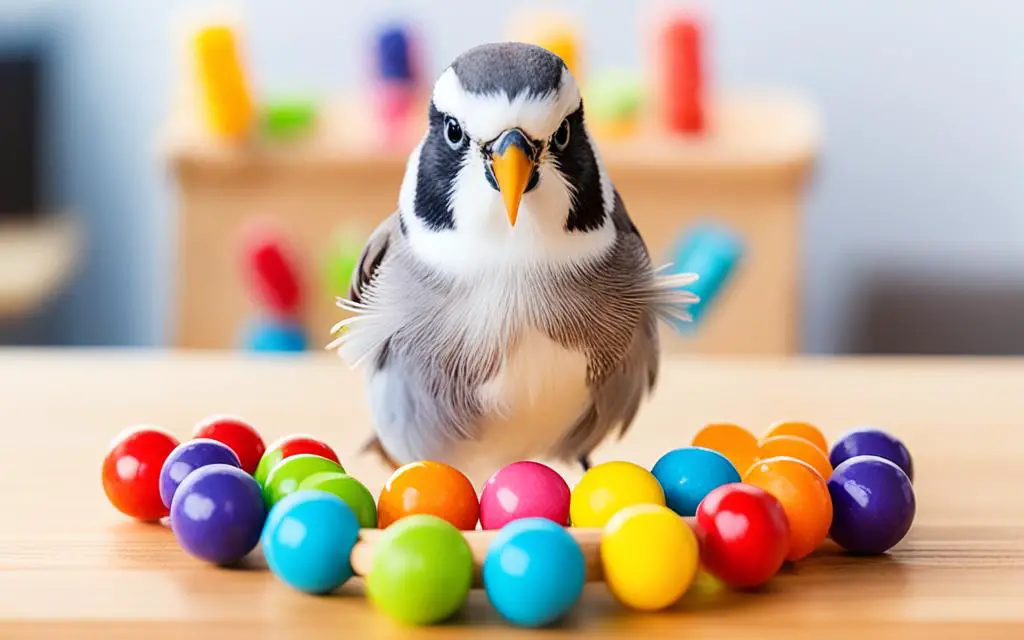
Aspiring to be the maestro in your bird’s symphony of tricks? First thing’s first: gather the props for your stage. You’ll need some choice bird treats, an array of engaging bird toys, a sturdy bird perch or two, and the ever-so-reliable bird training clicker. These essentials are not just items; they’re the keys to unlocking a world of interactive play and education that will keep both you and your feathered friend chirping in delight.
Choosing the Right Bird Treats
When venturing into bird trick training, selecting the right bird treats is similar to choosing the perfect seasoning—a dash too little and you’ve lost the flavor, too much and you overwhelm the palate. Watching which seeds make your bird bob with joy or which nut makes them squawk with pleasure is the perfect start.
Your bird isn’t just a simple song spinner; it’s a gourmand. Here’s a savvy tip for the trick trainee: variety is the spice of life. Experiment with fruits, pasta, and maybe a little bit of everything else in-between. Just remember, these enticing morsels are currency in the world of training—rare and given only for a performance well done!
Setting Up a Training Space
Now, imagine the training space as a cozy jazz club, where the vibe is just right. This is where your bird steps onto the stage—the bird perch, a T-stand for our purposes—and shines. They say location is everything, and they’re not wrong; a training space free from distractions ensures your bird’s attention remains as unwavering as a virtuoso’s focus.
Pair the ambiance with strategic placement of bird toys, and you’re ready to cue the music—or rather, the clicks. Yes, the bird training clicker takes center stage, delivering that snappy auditory cue that spells success for tricks well executed. Be a maestro of training with these tricks of the trade, and your bird’s talent will surely take flight, as will your shared joy. After all, isn’t happiness the truest measure of success?
| Item | Purpose in Training | Usage Tips |
|---|---|---|
| Bird treats | Positive reinforcement reward | Select healthful options in moderation |
| Bird toys | Training aids and mental stimulation | Rotate toys to keep training engaging |
| Bird perches | Perching and training versatility | Ensure stability and comfort for your bird |
| Bird training clicker | Marking desired behaviors | Consistent use for clear communication |
Fun Tricks to Teach Your Pet Bird
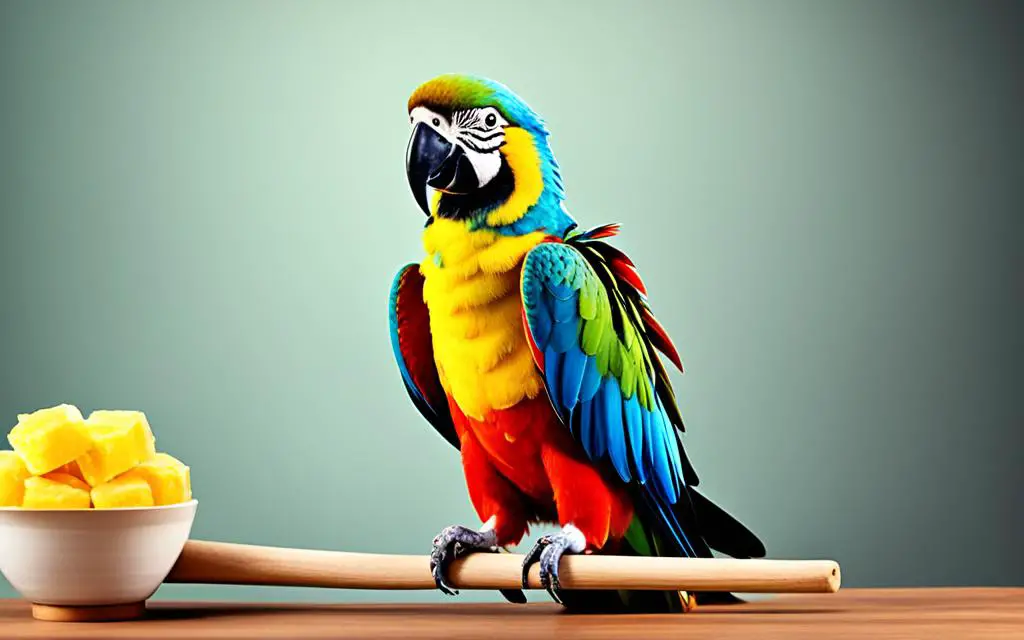
Picture this: Your feathery friend strutting their stuff, turning heads with some neat fun bird tricks that scream feathered flair. It’s not just a flight of fancy; with a sprinkle of patience and a dash of guidance, you can be the proud owner of a pet that’s both a joyous companion and a skilled entertainer. So buckle up as we soar into the realm of easy and enjoyable avian achievements!
Nothing spells E-A-S-Y like teaching your bird to wave hello. Does your heart not flutter at the prospect of your Polly putting the hand in handfeather, mimicking the queen’s wave with just a few treats and the magic word? What about the ‘Turn Around’—a parrot pirouette that’s sure to make any bird parent puff with pride? And let’s not forget ‘Take a Bow,’ where your bird channels its inner stage star after a successful trick performance, all with the flick of a treat.
Now, for those who aspire to have their winged companions go into full-on roleplay mode, ‘Playing Dead’ is your go-to script. With one fell swoop of a finger, your parrot or conure will flop over in an Oscar-worthy performance. And who could resist the cuteness of ‘Fetch’? It’s not just for pooches—birds can dive into the game, bringing you the spoils of their mini hunt straight to your palm.
To ensure your success in the grand venture to teach bird tricks, we’ve feathered together a table of the crowd favorites. Note the tricks, the desired effect, and the type of treats to use as your golden ticket to training triumph:
| Trick | Description | Treat Ideas |
|---|---|---|
| Waving | Parrot lifts a foot to greet you | Seeds, Nuts |
| Turning Around | Bird spins 360 on a perch | Fruits, Veggies |
| Taking a Bow | Bird bends forward elegantly | Pasta, Cooked Rice |
| Playing Dead | Bird lies on back, motionless | More exotic treats, for such drama! |
| Fetching | Bird retrieves item for you | Your choice—make it worth the return trip! |
But wait, there’s more! Once your avian has nailed the basics, why not jazz things up with ‘Dancing’? Shimmy alongside your bird to your favorite tunes for an impromptu boogie. And when you’re both ready for the major leagues, introduce the art of ‘Riding a Skateboard’—because sometimes, feathered friends need wheels too. With this repertoire, not only will you teach bird tricks but also intensify the bond—the ultimate cherry on top of this fun-filled sundae.
So let’s not wing it—plan out your training sessions with these easy bird tricks and watch your beloved bird become the life and soul of the party. It’s all about the treats, the clicks, and the praises. Ready, set, train!
Step-By-Step Guide to Training Your Bird
Ready to flip the script on your pet bird’s daily routine? It’s time to take center stage in the ultimate avian academy, with our straightforward guide to teaching your pet bird some nifty tricks. Assume the role of an avian impresario and embark on a remarkable journey of bird education that’s equally enthralling and rewarding.
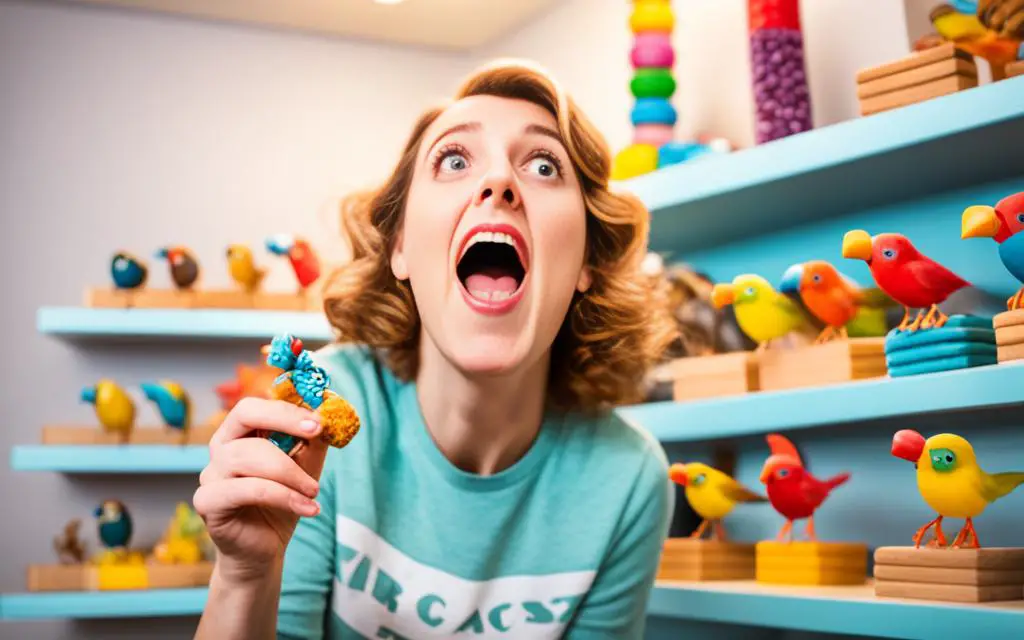
Introduction to Clicker Training
Any maestro knows the importance of a clear cue, and in the orchestra of bird training tricks, a clicker is your baton. The distinct sound it makes is music to your bird’s ears, signaling that they’ve nailed the performance and a treat is on its way. Clicker training lays the groundwork for an amicable rapport partitioned with tasty incentives. As your pet bird associates this auditory gold star with positive outcomes, you’re primed to conduct a symphony of success.
Teaching the Basic ‘Step Up’ Command
The ‘step up’ is the bread and butter of bird training—a fundamental maneuver that eases your budding avian virtuoso into the world of tricks. It’s like teaching a dancer their first two-step; it provides rhythm for more complicated routines later on. Arm yourself with delicacies and a helping of patience, because once your feathered pal masters hopping onto your digits at the drop of a command, the stage is set for grander ensemble acts.
Graduating to More Complex Tricks
After graduating from the ‘step up’, it’s time to raise the bar. Extend the playbill with tricks that challenge both mind and wings, like an aerial spin in response to your ‘turn around’ cue. Transition to props, like a button to ‘fetch’, before leveling up to the big leagues: ladders and skateboards. Each new conquest adds a line to your pet bird’s resume, transforming them from an opening act to the star of the show.
| Trick | Steps | Treats for Success |
|---|---|---|
| Step Up | Hold finger next to bird and command “step up” | Millet sprigs or tiny seed treats |
| Turn Around | Guide with a treat in a circular motion above the perch | Dried fruits or a small nut portion |
| Fetch | Introduce a brightly colored button and pair the action with a command | Choice cuts of fresh fruit or vegetable bites |
| Skateboard | Start with a stationary board and guide with treats for boarding | Whole nuts or a favorite specialty treat |
Common Mistakes to Avoid During Bird Training
When you decide to embark on the journey of bird trick training, keep in mind that even our feathered friends can have an ‘off’ day in the classroom. Whether you’re teaching pet bird tricks or delving deeper into bird behavior, there are certain foibles to sidestep if you want your winged pupil to soar. Below, we’ll ruffle through the do’s and don’ts, ensuring your bond stays aloft and your bird’s repertoire impresses.
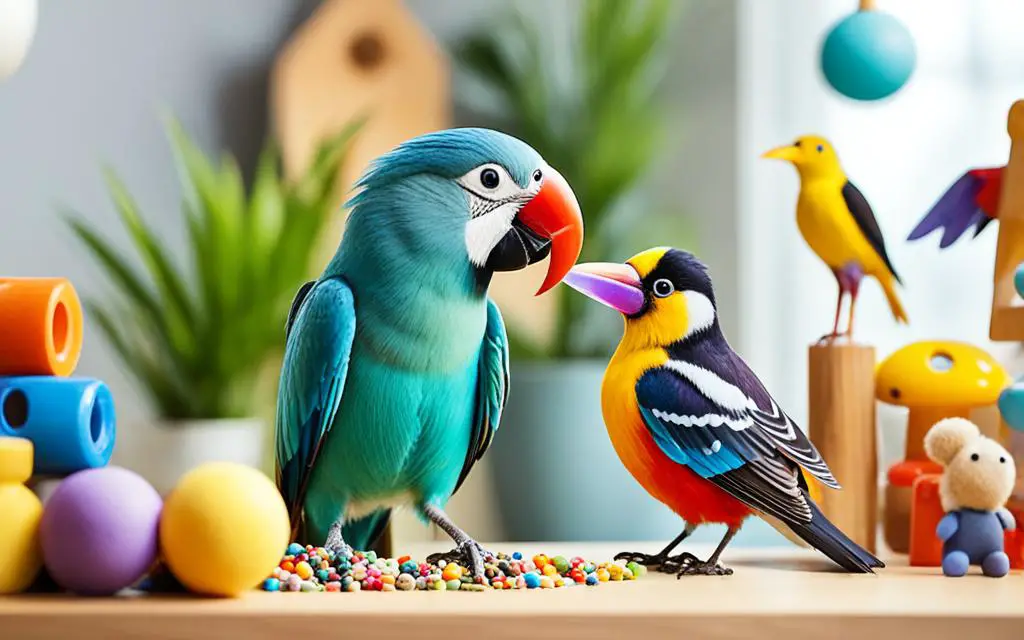
First and foremost, understand that the wing span of your bird’s attention is no wider than its actual wingspan. Lengthy training sessions can turn the quest for knowledge into an arduous slog. Aim for sessions that are short and sweet, enticing your bird to stay tuned for the next round.
It’s crucial not to pigeonhole all birds into a one-size-fits-all training regime. Birds are idiosyncratic creatures, each with a unique personality and threshold for patience. Consider your bird’s comfort like you would the right sized nest—it’s got to fit just right.
Consistency is key!
Bird brains, while smaller, are not so different from our own in that they love a good pattern. Use consistent commands and dispense that timely nugget of praise or treat. Birds, much like that guest who always overstates their welcome, will notice if you start to contradict yourself.
In light of that, here’s a pro tip: tossing a kernel of corn doesn’t cut it for a job well done. A treat should be a coveted prize, not an expected handout. Dole out the treats like they are rare pearls, guaranteeing every morsel is merited and every flit of beak behavior is rewarded suitably.
Now let’s flap into practice with a table that outlines typical errors and how to fly clear of them:
| Mistake | Upshot | Solution |
|---|---|---|
| Overlong Training Sessions | Waning interest, potential stress | Keep it short, keep it engaging |
| Forcing Uncomfortable Situations | Adverse reactions, loss of trust | Adapt to bird’s quirks and comfort zone |
| Inconsistency in Commands | Confusion, hindered progress | Maintain a steadfast routine |
| Ill-timed Rewards | Mixed messages, slow learning | Immediate and approprate positive reinforcement |
Remember, the sky’s the limit when it comes to what you and your avian ally can achieve together. By avoiding these common blunders, the path to becoming a fluent bird behaviorist is nothing but clear skies. So there you have it: steer clear of these snafus, and you’ll both be chirping a tune of success.
Caring for Your Bird’s Wellbeing During Training Sessions
Embarking on a journey of positive reinforcement training with your feathered companion isn’t just about sass and flash; it’s grounded in empathy and understanding. The flamboyance of bird behavior tricks should never come at the cost of their comfort. Here’s the lowdown on nurturing not just a well-trained wingster but a happy and healthy one, too.
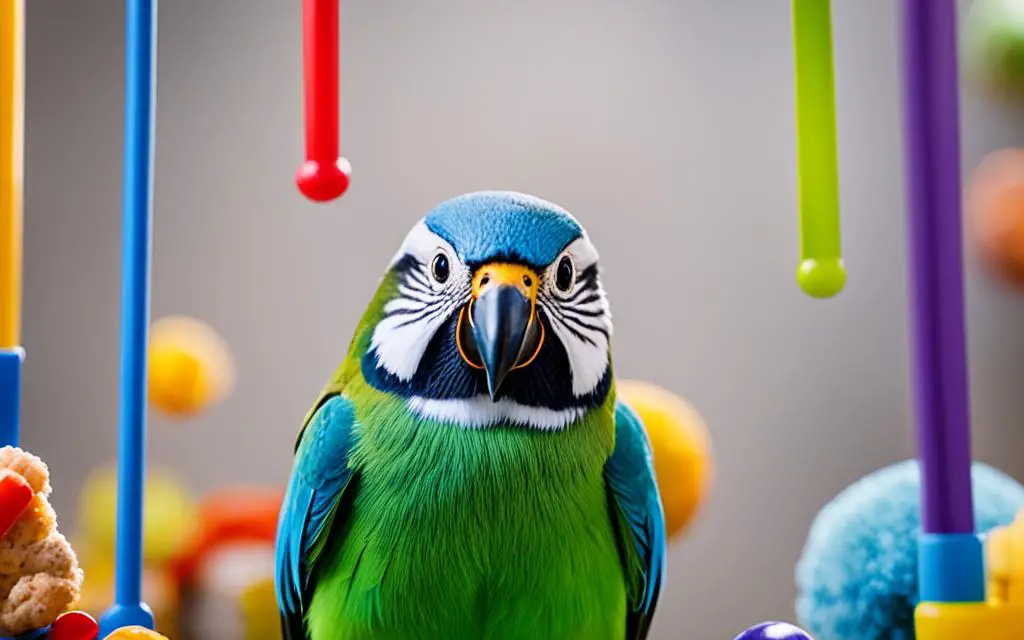
Reading Bird Behavior and Stress Signals
Peeling back the layers of bird behavior can seem more complex than your aunt’s seven-layer salad. But, with a bit of keen observation, we can discern a bird’s comfort jacket from its stress hoodie. Signs like feathers ruffled more than your grandmother’s Sunday hat, or a screech louder than nails on a chalkboard, are distress signals we ought to heed. It’s about understanding the subtleties; the difference between a happy chirp and a cry for peace. Tuning into these signals during training sessions isn’t just smart; it’s essential bird care.
Keeping Training Sessions Short and Enjoyable
When it comes to training sessions, think of them like a delightful afternoon tea – brief, frequent, and sweet. For our avian aficionados, a bite-sized stint of schooling pays dividends. Keeping it short ensures your bird is all-in, rather than plotting a feathered coup for being bored. Dole out treats because your bird showed up with enthusiasm, not just when it performs flawlessly. That’s the cherry on top of the bird care sundae: a positive, encouraging experience that has your bird eager for the encore.
Remember, we’re setting the stage for feathery fun—so keep those sessions as light and sparkling as a flute of the finest champagne.
Enhancing Bonding With Your Bird Through Tricks
When it comes to feathered friendships, the power of play is unparalleled. Tricks are an engaging way not only to train your pet bird but to create an unbreakable bond. It’s the splendor of sharing a language that transcends species boundaries, making every wing flap and chirpy “hello” a shared secret between you both.
Why Bonding Matters
The art of bonding with your bird is akin to making a new friend; it requires time, patience, and lots of shared laughter (and treats!). A bond cements the relationship, ensuring your feathered buddy sees you as a trusted companion rather than a looming giant. It’s the heartbeat of the bird world, where mutual respect and fondness grow stronger with each successful ‘shake-a-tail-feather’.
Tricks That Promote Trust and Affection
Picture this: a morning where your winged pal glides onto your open journal, not just because it’s there, but because it’s you holding it. Tricks like ‘fetch’, where the bird swoops down to retrieve a small bauble only to return it to you, are sprinkled with trust. Or consider ‘shoulder sitting’, where your bird learns to find solace in the perch of your shoulder, whispering avian secrets as you both meander around the house.
Building a routine around these tricks doesn’t just sharpen your bird’s wits; it cements a sense of safety and belonging. Just like humans, birds flourish in an environment of consistent love and positive reinforcement.
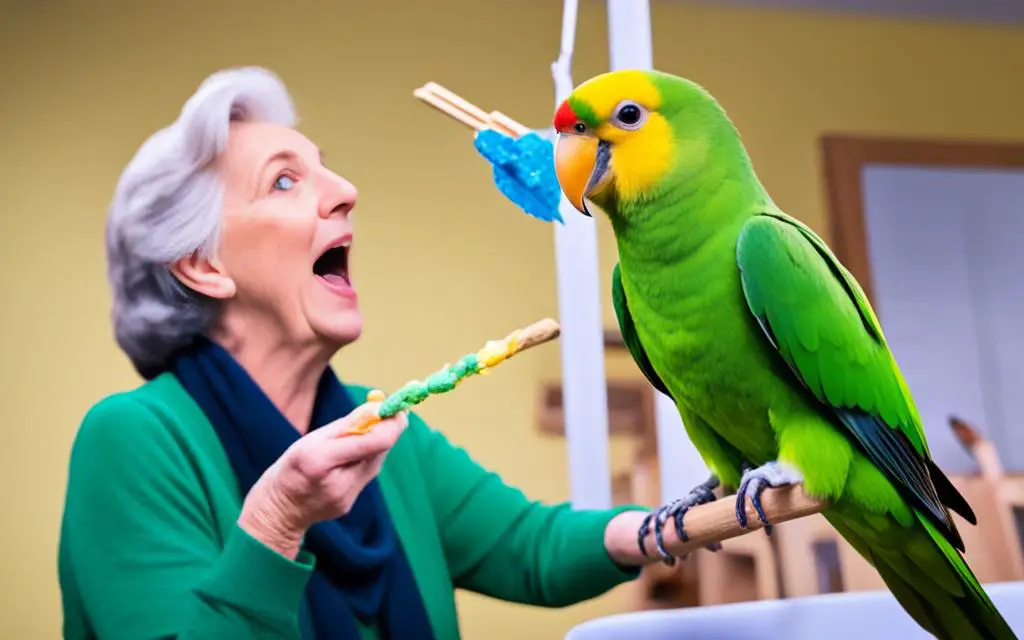
| Trick | Description | Impact on Bond |
|---|---|---|
| Fetch | Bird retrieves and returns an item | Promotes cooperative interaction and dependency |
| Shoulder Sitting | Bird perches on the owner’s shoulder | Builds trust and companionship |
| Wing Wave | Bird flaps its wing on command | Creates a unique greeting between bird and owner |
With these bird training tips in your arsenal and some tidbits of patience, you’ll be all set to train your pet bird into not just a pupil with wings, but your closest confidante. So ready those treats, tune into your bird’s body language, and let the training triumphs begin. Before you know it, your bird will be bonding over tricks, looking at you not just as a provider but as a partner-in-play. That’s certainly something to chirp about!
Advanced Tricks for the Ambitious Pet Bird
For those bird enthusiasts eager to reach new training heights, setting your sights on advanced bird tricks may open a window to a whole new aerial landscape. With your pet bird’s natural agility and smarts, embarking on a higher level of bird trick training not only showcases their incredible capabilities but also caters to their cognitive needs. Let’s perch on the idea of “advanced” for a second — think intellectual Olympics for birds; an array of activities that soar way beyond a simple ‘step up’.
Target Training for Precision and Focus
Target training is like the bird-world’s version of hitting the bullseye. It’s about precision, patience, and a shared sense of accomplishment when your feathered archer strikes true. Begin with a non-threatening target stick and draw your bird to it using their favorite treats. When they touch it, sound the clicker; this becomes an operatic cue for victory and yumminess.
The steps for this aerial artistry might run as follows:
- Introduce the target stick and wait for a ‘nose boop’ from your bird.
- Mark the success with a clicker and reward their accuracy with an irresistible treat.
- Slowly increase the distance, turning this activity into a feathered game of precision tag.
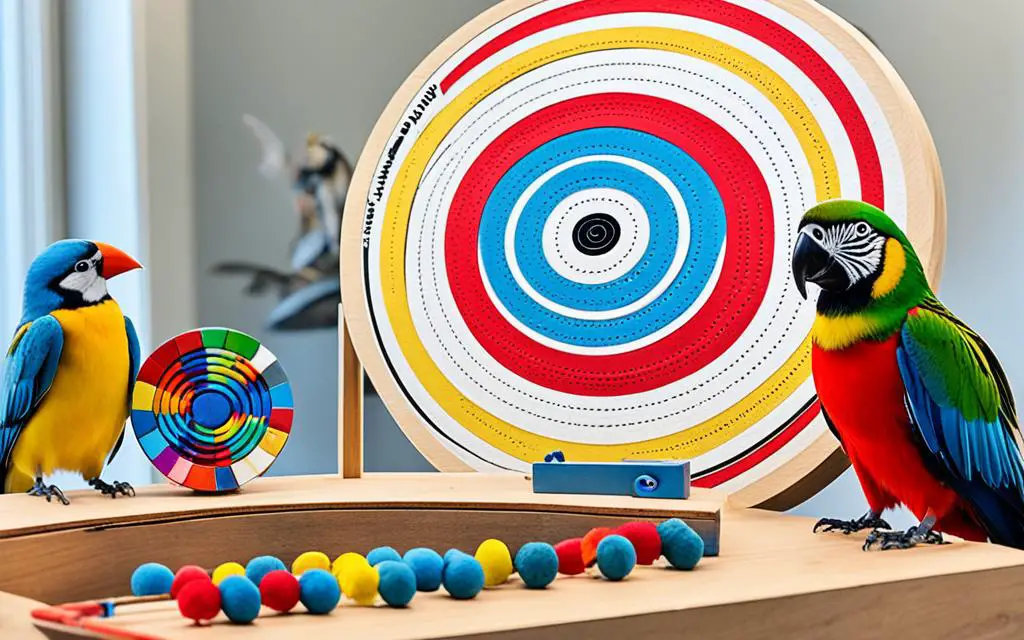
And there you have it, a path to trick stardom where your bird learns that a slight tap leads to big rewards. Consider it a “tick-tock” towards an “a-ha” moment shared between you and your avian virtuoso.
Intellectually Stimulating Challenges for Your Bird
Once you’ve feathered the nest of basic trick training, it’s time to spread those wings into more complex territories. Advanced pet bird tricks are the Rubik’s Cubes of the bird world, challenging their intellectually capable minds. You’ll be teaching not just tricks, but life skills that could make Mensa members envious.
| Trick | Objective | Training Props | Bird’s Reaction |
|---|---|---|---|
| Climbing a Ladder | Encourage elevation with style | Miniature ladder | Peer over new peaks with pride |
| Riding a Skateboard | Coast through the living room | Parrot-sized skateboard | Bird’s eye view from a half-pipe |
| Puzzle Solving | Testing problem-solving skills | Complex puzzles | Feathers furrowed in focus |
| Painting | Unleash artistic instincts | Non-toxic paints, canvas | Peck-casso in the making |
Birds are not just wings and beaks, they’re Picasso with plumage, Einstein with eggs. By diving into the art of advanced bird tricks, we’re not just training; we’re cultivating a shared language that’s both fulfilling and a hoot to watch. So let’s not clip the wings of possibility—aim for the sky and watch your pet artistically soar!
Conclusion
As we nestle down to the conclusion of our aerial adventure in avian amusements, it’s crucial that our bird training tips have taken root in the garden of your mind. The essentials of bird training—woven from the sturdy strands of clicker training, a solid grasp of bird behavior, appropriate trick selection, and unwavering positive reinforcement—are your training toolkit. Patience and consistency are not merely virtues in this realm; they are the very architecture that supports a bird’s ability to thrive in training and in spirit.
Recap of Bird Training Essentials
The foundation of your bird training growth has been meticulously laid out with the hope that you’ll build an edifice of education and enjoyment. As we’ve flitted from one training tip to the next, remember that each parrot’s pirouette and every cockatiel’s cantata is underscored by your steadfast commitment to their wellbeing. Employing these methodologies ensures that the feathered journey you embark on is constructive, compassionate, and crammed with mutual gratification.
Encouragement for Continued Learning and Growth
And, oh, what sublime skyscapes lie ahead for those daring to continue bird training! As you fine-tune your training symphonies, celebrate each small step and chirp with due pomp and revelry. There’s always room to add more tricks to your bird’s repertory, more bonding experiences to sweeten your shared life. Your avian companion’s intelligence is a sunbeam, yearning to radiate in the challenge and camaraderie of your joined exploration. Stoke this fire, embolden your spirit, and may your shared journey be ever climbing towards new horizons of companionship and capering delights.
FAQ
What are some fun tricks to teach your pet bird?
How intelligent are pet birds and what species can learn tricks?
Why is positive reinforcement important in bird training?
Which treats are best for bird trick training?
What’s a good setup for bird training?
How do I start clicker training with my bird?
What’s the first trick to teach my bird?
What are some common bird training mistakes to avoid?
How can I tell if my bird is stressed during training?
Why should I teach my bird tricks?
What advanced tricks can I teach my ambitious pet bird?
Source Links
- https://www.omlet.us/guide/parrots/training_a_parrot/tricks/
- https://www.thehappychickencoop.com/tricks-to-teach-your-bird/
- http://theparrotforum.com/viewtopic.php?f=11&t=227

My name is Shane Warren, the author behind Your Bird Buddy – your ultimate guide to the wonderful world of birds! Unleash your inner avian explorer as we delve into a vibrant library of knowledge dedicated to all things feathered. From learning about diverse bird species from across the globe to understanding their captivating habitats and behaviors, I’m here to fuel your passion for these magnificent creatures. Not only that, but I also provide valuable insights on being a responsible and informed pet bird owner. Join our vibrant community and let’s celebrate the feathered wonders of the world together – one chirp at a time. And be sure to join our Your Bird Buddy Community over on Facebook!

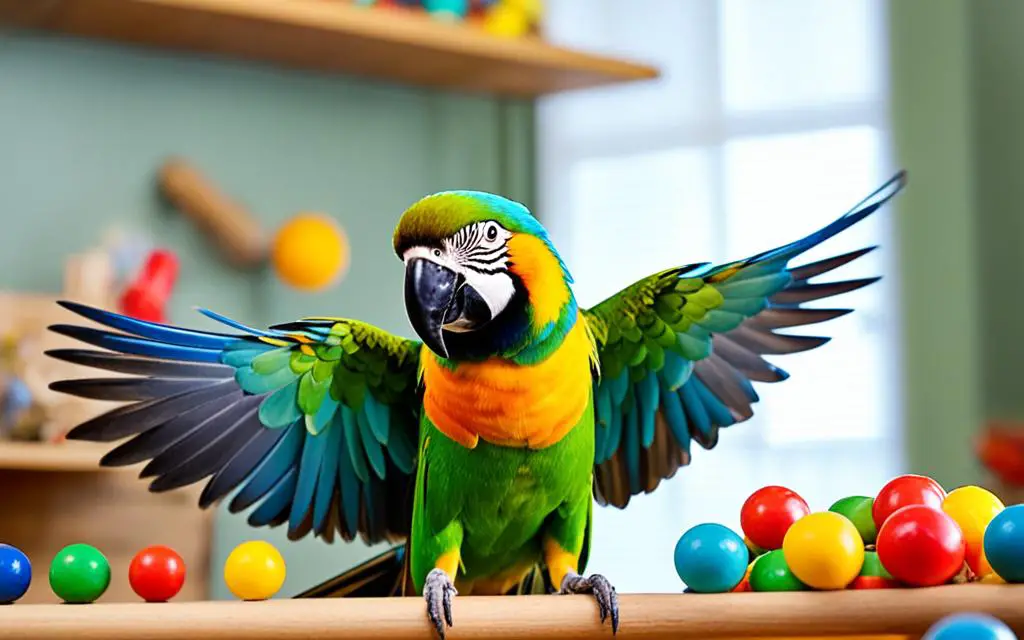
Comments are closed